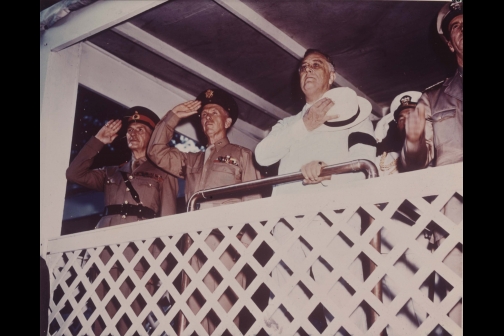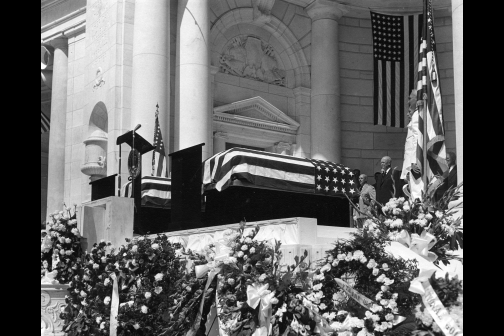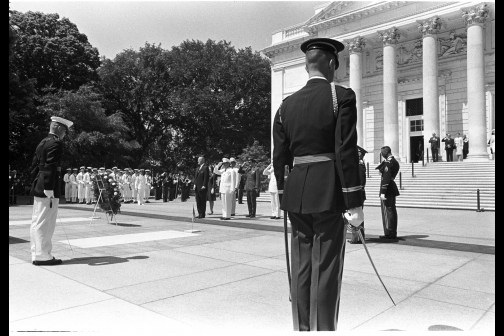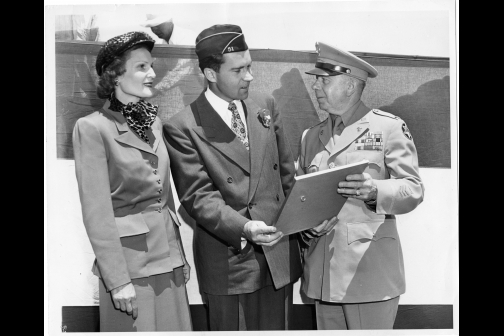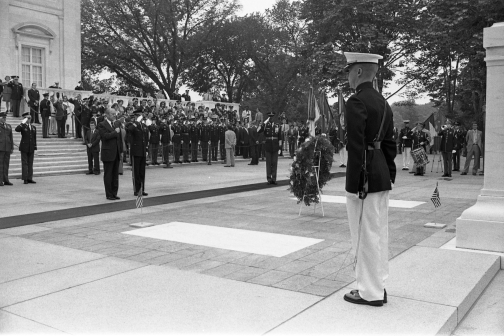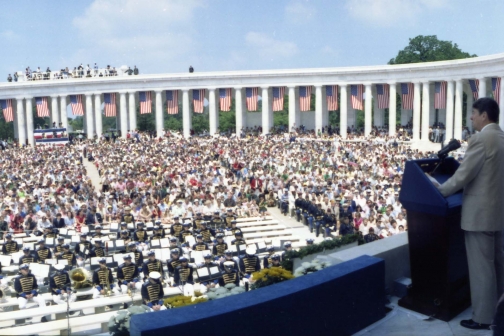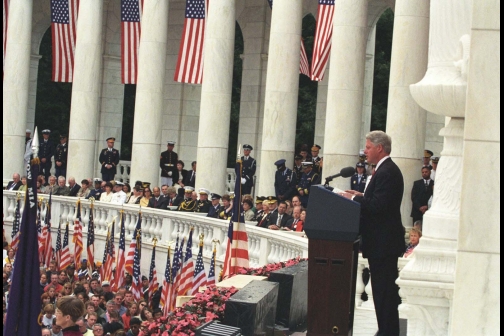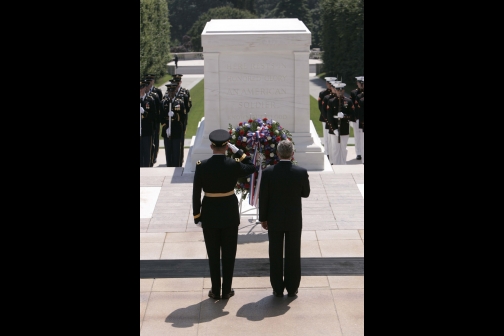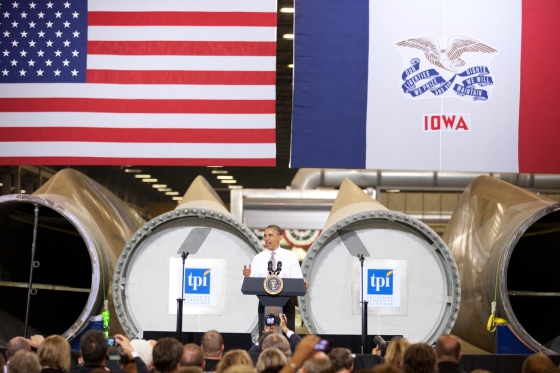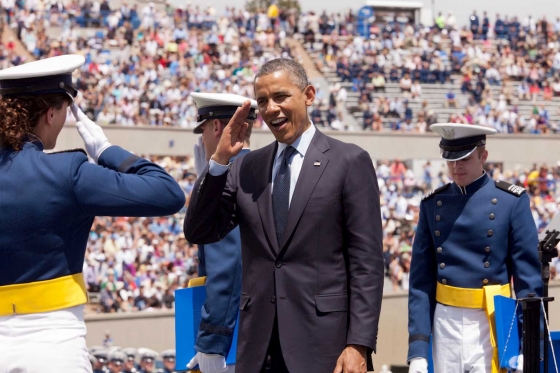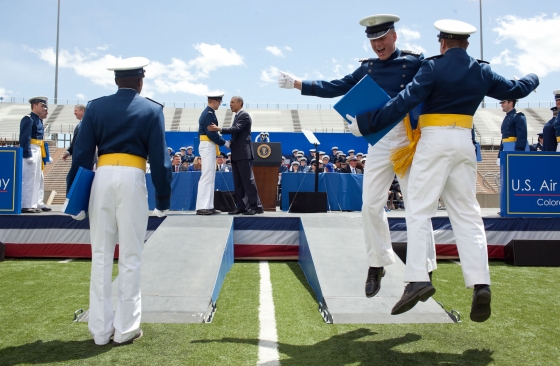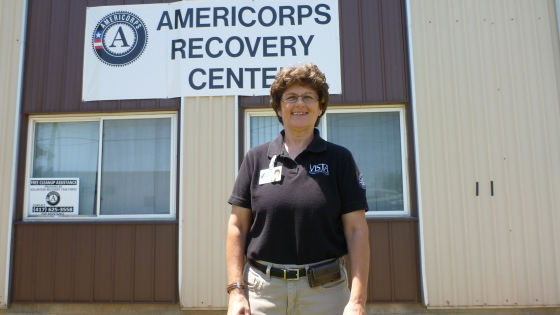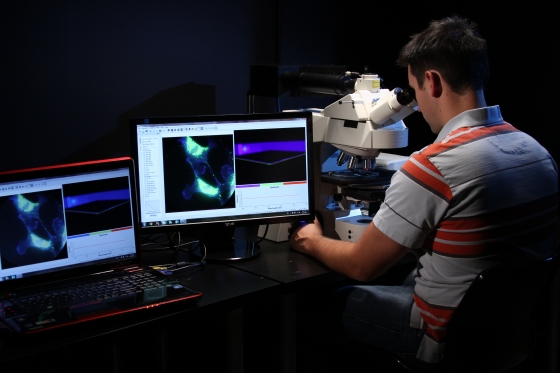-
Note: This live session of Office Hours has concluded. View the full question and answer session below or at Storify.com
Monday, May 28th is Memorial Day, when we honor and reflect upon the sacrifices of the men and women who have defended our nation. Memorial Day also marks an opportunity to find ways for all of us to support veterans and military families.
To discuss Joining Forces and opportunities to mobilize all sectors of society to give our service members and their families the support they have earned, we’ll be hosting a session of Office Hours on Tuesday, May 29th at 2:00 pm ET with Brad Cooper, a Navy captain and the executive director of Joining Forces. Have questions?
Here’s how White House Office Hours work:
- Ask your questions now and during the live event on Twitter with the hashtag #WHChat
- Follow the Q&A live through the @JoiningForces Twitter account
- If you miss the live session, the full session will be posted on WhiteHouse.gov and Storify.com/WhiteHouse
So, stop by for Office Hours at 2:00 p.m. ET on Tuesday, May 29th with Brad Cooper and be sure to follow @JoiningForces on Twitter for the latest news and more opportunities to engage.
-
May 25, 2012
12:25 PM EDTMemorial Day was originally called Decoration Day -- a time set aside to honor fallen soldiers of the Civil War by decorating their graves with flowers. The first Decoration Day was observed on May 30, 1868, three years after the end of the Civil War. On that day, the largest known ceremony was held at Arlington National Cemetery, near Washington D.C..
Over time, people adopted the name Memorial Day, and ceremonies were held across the country to honor all U.S. soldiers who had died at war. On May 11, 1950, Congress issued a joint resolution requesting that the President proclaim a “Prayer for Peace” on each Memorial Day. In 1971, Congress declared Memorial Day a federal holiday to be held on the last Monday of every May.
This Memorial Day, we honor the men and women who have served our country. Here is a selection of Memorial Day photos and speeches from the holdings of the Presidential Libraries of the U.S. National Archives. For more information, visit: http://www.archives.gov/presidential-libraries/
-
Through Joining Forces, Americans continue to step up and respond to the First Lady and Dr. Biden's call to serve our troops and their families as well as they have served us.
Last week, the Department of the Interior joined forces with the First Lady and Dr. Biden to provide free access to more than 2,000 of America's parks to our troops and their families. Then on Monday of this week, Blue Star Families and the National Endowment for the Arts launched "Blue Star Museums" -- laying out the welcome mat for free access at more than 1,600 museums around the country for service members and military families.
Connecting veterans and military spouses with employment opportunities in the private sector has been a priority for the First Lady and Dr. Biden, and the effort is paying off. In the last year, more than 1,600 companies have hired more than 70,000 veterans and military spouses through Joining Forces.
Just last week, 34 more companies and organizations joined forces with the Military Spouse Employment Partnership (MSEP), a partnership of more than 130 companies committed to hire and retain military spouses. Since June of last year, MSEP companies have hired more than 22,000 military spouses.
And the momentum keeps building. Check out Joining Forces employment efforts in just the last three days:
-
Yesterday, in partnership with industry, we took a step forward in better understanding the capabilities of our power grid and how we can improve our ability to protect it against cybersecurity threats.
Deputy Secretary of Energy Dan Poneman, Deputy Secretary of Homeland Security Jane Lute and I hosted industry executives to conclude the Electricity Sector Cybersecurity Capability Maturity Model initiative that we launched in January. This White House initiative has shown encouraging results as a tool to evaluate and strengthen cybersecurity capabilities and enable utilities to prioritize their actions and their cybersecurity investments.
From the beginning of this initiative, our industry partners in this effort have been engaged at the executive level, which has made all the difference in how this effort helps raise awareness and institutionalizes processes within utilities and across the sector. I challenge all of the participants to continue the leadership you have demonstrated to continue strengthening cybersecurity capabilities.
-
May 25, 2012
12:09 PM EDTFollowing today's historic berthing of the SpaceX Dragon spacecraft to the U.S. Harmony module of the International Space Station, John P. Holdren, Assistant to the President for Science and Technology, issued the following statement:
For the first time, a private American company has successfully launched a spacecraft into orbit and berthed it with the International Space Station—an achievement of historic scientific and technological significance and a key milepost in President Obama’s vision for America’s continued leadership in space.
That is exactly what the President had in mind when he laid out a fresh course for NASA to explore new scientific frontiers and take Americans ever deeper into our Solar System while relying on private-sector innovators—working in the competitive free market—to ferry astronauts and cargo to Low Earth Orbit and the International Space Station. It’s essential we maintain such competition and fully support this burgeoning and capable industry to get U.S. astronauts back on American launch vehicles as soon as possible.
I could not be prouder of our scientists and engineers—both government and private sector employees—who have contributed to this historic mission. A passion for discovery and a sense for adventure have always driven this Nation forward, and I join all Americans in watching what future possibilities are enabled by today’s great achievement.
-
In Iowa this afternoon, President Obama continued to press lawmakers to take action on his To-Do List for Congress.
He traveled to Newton to push for the renewal of a tax credit for companies that produce clean energy. The credit currently supports as many as 37,000 jobs.
His host for the visit was TPI Composites -- a company that makes blades for wind turbines and employs more 700 people.
"If Congress doesn’t act, companies like this one will take a hit," he said. "Jobs will be lost. That’s not a guess, that’s a fact. We can’t let that happen."
Currently, 20 percent of all the electricity used in the Iowa is generated by wind power, and there are currently more wind power jobs in the state than in any other in America.
Overall, the United States generates enough electricity from wind to power 10 million homes. And there are 500 production facilities in 43 states putting people to work in that industry.
Later, he answered questions about the To-Do List on Twitter.
-
Yesterday, SBA Administrator Karen Mills, and the four winners of the National Small Business Week Video Contest, participated in a Google+ Hangout moderated by Diana Ransom from Entrepreneur.com. Administrator Mills and the contest winners answered questions from Twitter submitted using the hashtag #WHHangout and discussed the various ways the SBA is helping small business owners, such as special services for veterans, export loans, and loans for acquisitions.
Additionally, the winners - KissTixx, Rodgers’ Banana Pudding Sauce, Rustic Crust, and The Fresh Diet - shared stories about the creation and expansion of their small businesses, and gave tips on how they created the winning video submissions.
Don’t miss the SBA video contest winners highlights reel and visit SBA.gov for more information about the video contest and how the SBA is supporting small business all across the country.
-
Yes, President Obama was on Twitter today – taking your questions about his plan to create jobs and help the middle class.

Earlier, the President paid a visit to TPI Composites, a wind manufacturer in Newton, Iowa. At the plant, he called on Congress to act on a to-do list that’ll create jobs, specifically highlighting the need to invest in clean energy.
After the speech, the President answered some of your questions on Twitter. Check out the full Q&A below and learn more about clean energy tax credits and the other items on the to-do list here. To see more conversations like this one, check out some of our recent White House Twitter “Office Hours” at Storify.com/WhiteHouse.
-
May 24, 2012
02:36 PM EDTIn his 2012 State of the Union Address, President Obama stated his goal to turn the nation’s unemployment system into a reemployment system. One way we can do this is to leverage and foster the entrepreneurial spirit of the nation’s unemployed workers, helping those who have lost their job transition to creating jobs. Included in the payroll tax cut and unemployment insurance legislation the President signed into law in February was a provision called Self-Employment Assistance, or SEA, that allows states to empower unemployed workers to start their own businesses.
The idea is simple: Some laid-off workers have the skills, experience, and entrepreneurial ambition to launch a successful business, but they are locked into an inflexible system. If they stop looking for traditional work full-time, they will lose their unemployment benefits. Instead, SEA allows an entrepreneur with a viable business plan to receive those same unemployment benefits, as long as they are working full-time to get a new company off the ground.
We know that this model works, because several states have already established successful programs over the past two decades. In multiple studies, SEA has been shown to increase the success of entrepreneurs, and increased their earnings from self-employment.
Take Rakia Reynolds, who in 2007 found herself laid off from her job as a TV producer in Philadelphia. She discovered that Pennsylvania would allow her to dedicate herself to the all-consuming process of starting a new business, while continuing to receive unemployment benefits for a limited time to support her family. She founded the public relations firm Skai Blue Media, and in just a few years hired six employees and established her company as a PR leader in Philadelphia.
Or take Adam Lowry and Michael Richardson, two software developers in Portland, Oregon whose employer went out of business in 2009. Self-employment assistance allowed them to pursue their entrepreneurial ambitions and launch Urban Airship, an innovative mobile advertising company that now employs 75 workers, and promises to keep on growing.
America is full of potential success stories like these. As part of the White House-led Startup America initiative to accelerate the success of job-creating entrepreneurs across the country, the President first proposed to expand SEA last September in the American Jobs Act. TIME called SEA “the most important (and overlooked) proposal” included in the American Jobs Act. SEA was one of several work-based reforms passed into law in February as part of the first major overhaul of the unemployment insurance system in decades.
Today, the Labor Department issued technical guidance to put the new law into practice, extending this opportunity to the long-term unemployed, connecting entrepreneurs with mentorship and business development resources through the Small Business Administration and local partners, and giving states the tools to get new SEA programs off the ground. The goal of this guidance, and of the legislation that generated it, is to give thousands more entrepreneurs the opportunity that Lowry, Richardson, and Reynolds had—to realize their dreams of self-employment, creating profits for themselves and jobs for others in the process.
Danielle Gray is Deputy Assistant to the President for Economic Policy. Tom Kalil is Deputy Director for Policy for the White House Office of Science and Technology Policy and Senior Advisor for Science, Technology and Innovation for the National Economic Council. -
May 24, 2012
01:07 PM EDTAt USDA’s Food and Nutrition Service we are committed to keeping our vital nutrition assistance programs available to those who need them most. One way to do that is to ensure access. Another is to ensure integrity—Americans expect us to serve those in need, and they expect us to do so with accountability for the benefits provided.
That why today, as part of the Obama administration's ongoing Campaign to Cut Waste, we’ve announced a proposed rule that will provide States with additional tools to maintain integrity in the Supplemental Nutrition Assistance Program (SNAP), also known as food stamps. The proposed rule will help States identify and prevent fraud by allowing them to request client contact when there are excessive Electronic Benefit Transfer (EBT) card replacement requests by SNAP households. The rule also further clarifies the definition of what constitutes trafficking. These new tools are important because excessive card replacement requests by SNAP recipients may indicate that the client does not know how to use the card properly and needs additional help or training, or that fraudulent activity may be occurring that warrants further investigation by the State. To be clear, we expect most requests for replacement cards to be legitimate ones; however, it’s important that we take a closer look at those cases in which cards are replaced at an excessive rate.
Under our new policy, States can now hold off on replacing an EBT card until the household making the request makes contact with the State office and provides an explanation. The proposed rule provides States the option to require SNAP recipients to make contact with the state when there have been an excessive number of requests for card replacement in a year--a threshold defined by the State agency but no fewer than 4 requests, unless there is sufficient additional evidence of misuse. Previously, States did not have this authority.
-
Tomorrow the President will travel to TPI Composites in Newton, Iowa where he will highlight steps Congress can take right now to create American jobs, and support American companies and manufacturers – all while continuing to increase clean energy production here at home.
As part of his Congressional To-Do List, the President will call on Congress to pass legislation that will extend the Production Tax Credit (PTC) – which provides an important tax credit to utility-scale wind producers in the United States – alongside an expansion of the 48C Advanced Energy Manufacturing Tax Credit that supports American-made clean energy manufacturing in towns and cities across the country. According to industry estimates, the wind industry supports nearly 20,000 direct jobs along with over 30,000 manufacturing jobs in its supply chain, and some in industry have estimated that without extending the PTC, as the President is calling for, up to 37,000 jobs could be lost.
-
Four years ago, when President Obama made his first trip to the Air Force Academy in Colorado Springs, Colorado, the class of 2012 was just beginning their tenure as cadets.
Today, he returned to deliver their commencement address. Acknowledging the continued need for the leadership and service the new graduates will provide, President Obama said the next century will be an American one:
I see an American Century because of the character of our country -- the spirit that has always made us exceptional. That simple yet revolutionary idea -- there at our founding and in our hearts ever since -- that we have it in our power to make the world anew, to make the future what we will. It is that fundamental faith -- that American optimism -- which says no challenge is too great, no mission is too hard. It’s the spirit that guides your class: "Never falter, never fail."
Approximately, 1,000 cadets graduated today and will soon begin their commissions as second lieutenants. Before leaving Falcon Field the President shook each of their hands.
Read his full remarks here.

Graduates toss their hats as the Thunderbirds flyover during the United States Air Force Academy commencement ceremony at Falcon Stadium, USAF Academy in Colorado Springs, Colorado, May 23, 2012. (Official White House Photo by Chuck Kennedy)
-
At the U.S. Small Business Administration, we have the great privilege to work with many amazing small business owners. Every day I see how small businesses are creating an economy built to last and living the American Dream. I wanted to share these great stories with everyone – so we asked small business owners to share their stories in a short video that demonstrates how their business benefited from the SBA and makes a difference in their local community.
The response to SBA's first video contest was incredible – we received over 100 submissions! It was a difficult process, but SBA selected four winners to participate in the Google + Hangout with me. Thanks to all contest participants for taking the time from your busy schedules to submit these outstanding videos. We look forward to highlighting all the videos on our website in the coming weeks.
Drum roll please…!
The winners of the 2012 National Small Business Week Video Contest:
KissTixx, Orem, Utah
Dallas Robinson and Mike Buonomo started KISSTIXX Lip Balm as a project in college. They created a high quality SPF lip balm that was packaged in two compatible flavors, one for you and one for your special someone. The two flavors would combine on contact creating a new flavor or experience when you kiss. They have flavors like Fire & Ice that heat and cool the lips, Raspberry & Lemonade and Strawberry Daiquiri & Pina Colada. As students they needed the help of the SBA to create product to meet the demand. The SBA stepped up and now KISSTIXX gets inquiries all over the world. They are currently negotiating deals with major retailers stateside and expanding the kissing experience into over 30 countries. They were even able to convince celebrity billionaire Mark Cuban to financially back their company.
Check out this video of KISSTIXX:
Rodgers' Banana Pudding Sauce; Chesapeake, Virginia
Reggie Rodgers is the Managing Director of R.R. Enterprise - better known as Rodgers’ Banana Pudding Sauce, located in Chesapeake, VA. Reggie is a service-disabled veteran, serving 26 years with the Navy. In his first year of business, Reggie and his family worked with their local Small Business Development Center in Chesapeake to learn the nuts and bolts of operating a business. They are now in the process of applying for a Patriot Express Loan, after attending a military community workshop at an SBDC in Hampton, VA.
-
Summer Jobs+ is a call to action for businesses, non-profits, and government to work together to provide pathways to employment for young people in the summer of 2012. It's about helping people find their first jobs.
Today Nancy-Ann DeParle is an Assistant to the President and Deputy Chief of Staff at the White House. It's a big change from her very first summer job, working as a soda jerk in a drugstore in Rockwood, TN -- although Nancy-Ann says that too was "awesome." Check it out:
So far, employers have committed to providing more than 300,000 jobs, mentorships, and other employment opportunities this summer through Summer Jobs+.
You heard about Nancy-Ann's first job. Now go find yours.
Learn more
- Watch Arne Duncan, U.S. Secretary of Education, talk about his first job
- Watch Cecilia Munoz, Director of the White House's Domestic Policy Council, talk about her first job.
- Watch Jimmy Fallon talk about his first job.
- See the list of employers and organizations participating in Summer Jobs+
- Check out a range of web and mobile apps designed to connect young people to jobs.
-
This op-ed by Dr. Jill Biden was first published in The Hill
Over the past few years, I have been blessed with the opportunity to spend time with our veterans, troops and military families. With every visit, I come away inspired.
They are military spouses, who balance work, family and school — all while dealing with the emotions of a deployment. They are military children, who move from school to school while picking up extra chores while their dad or mom is away serving our country. They are survivors of our fallen, who are pillars of strength for their communities. And of course, they are our troops, veterans and wounded warriors, who have dedicated their lives to defending America.
This Memorial Day, we must remember that these heroes are found in every corner of our country, from big cities to rural areas, from base communities to small towns. But no matter where they are assigned or what their duties are, when our service members are called to serve, so too are their families.
That’s why one year ago, first lady Michelle Obama and I launched Joining Forces, an initiative to bring Americans together to recognize, honor and serve our nation’s veterans and military families. Joining Forces focuses on three key areas — employment, education and wellness — while raising awareness about the service, sacrifice and needs of our troops, veterans and their families.
When we first started thinking about this concept, we were pretty confident that Americans would answer the call. But the response we’ve seen in our first year has been simply overwhelming.
-
Ed note: this was originally posted on The Commerce Blog, the official blog of the US Department of Commerce
Yesterday's U.S. Census Bureau report shows that not only was the 2010 Census delivered on time and significantly under budget – but even more important, it was extremely accurate. I am proud of the extraordinary accomplishment by the Census Bureau and the Commerce Department in its success with the massive 2010 Decennial Census effort that gathered data vital to understanding our nation’s population and to allocating equal representation in our democratic system. The accuracy of the 2010 Decennial Census is particularly impressive considering outside predictions of failure. The Census was able to reverse a decades-long decline in survey response rates with its 2010 count.
The data released yesterday are from a post-enumeration survey of the 2010 Census called the Census Coverage Measurement (CCM) program, which measures the accuracy of the coverage of the nation’s household population (excluding the 8.0 million people in “group quarters,” such as nursing homes or college dorms). It surveys a sample of the 300.7 million people living in housing units and then matches the responses to the census, providing an estimate of exactly who was or wasn’t counted in the census. The results found that the 2010 Census had a very small net overcount–just 0.01 percent–which is statistically virtually the same as zero, and a significant improvement over the 0.49 percent overcount in 2000 and 1.61 percent undercount in 1990. You can learn more about how the Census Bureau conducts the CCM survey after the census to help measure its quality.
-
When the Internet revolution arrived in the 1990s, the U.S. Government embraced this new medium to interact with the American people. Today, what started as basic information pages has evolved into sophisticated transactional systems that allow us to pay taxes online, download medical records, and so much more.
Like the 1990s, we are now in the midst of another important shift in how people consume and deliver information and services. In 2011, global smartphone shipments exceeded personal computer shipments for the first time in history, and more Americans will soon access the Internet via mobile devices than desktop PCs. The rise of mobile further compounds the challenge of providing high-quality digital services in a cost-effective and efficient manner.
That’s why President Obama issued a directive today to make important services accessible from your phone and charged me with developing a comprehensive strategy to build a 21st Century Digital Government that delivers better digital services to the American people.
Today marks the launch of that Digital Government Strategy (PDF / HTML5).
At its core, the strategy takes a coordinated, information- and customer-centric approach to changing how the government works and delivers services to the American people. Designing for openness from the start – making open data the default for government IT systems and embracing the use of web APIs – enables us to more easily deliver information and services through multiple channels, including mobile, and engage the public and America’s entrepreneurs as partners in building a better government.
-
Today, we are very excited to be launching the new Presidential Innovation Fellows program. This new initiative will bring top innovators from outside government for focused “tours of duty” with our best federal innovators on game-changing projects. Combining the know-how of citizen change agents and government change agents in small, agile teams that move at high speed, these projects aim to deliver significant results within six months.
We are kicking off the program with five projects that seek to save taxpayers money, fuel job creation, and improve the return government is delivering to the American people:
- The Open Data Initiatives Program: This program aims to stimulate a rising tide of entrepreneurship that uses data from governmental and non-governmental sources to create tools that can help Americans better navigate their world, such as by finding the right health care provider, identifying the college that provides the best value for their money, saving money on electricity bills through smarter energy shopping, keeping their families safe by knowing which products have been recalled, and much more. Building upon prior success stories in which entrepreneurial innovators built amazing products based on the release of weather, GPS, and health-related data, this program will speed and expand the release of government data and voluntarily-contributed private-sector data in machine-readable form in realms including health, education, energy, safety, the nonprofit sector, and personal finance. Through ideation workshops, codeathons, and “datapaloozas” that showcase the best innovations, the program will actively stimulate the creation of new apps and services by creative entrepreneurs– improving the lives of Americans in many tangible ways and creating jobs of the future at the same time.
- Blue Button for America: This initiative will seek to expand nationwide adoption of Blue Button, a capability that enables consumers to securely download electronic copies of their own health information. It will create tools that make adoption and operation of Blue Button even easier by public-sector and private-sector organizations, and also stimulate the development of new apps and services by entrepreneurs that can help consumers use Blue Button data to improve their health and care.
- MyGov: This project will reimagine the relationship between the Federal Government and citizens by rapidly prototyping a streamlined, intuitive online system that Americans can use to easily access the right information and services for them from across the U.S. Government and also provide feedback about their interactive experience.
- RFP-EZ: This project will develop a process and a platform that makes it easier for the Federal Government to procure innovative technology solutions from small, high-growth companies. This will enable more startups to access the government marketplace, fueling job growth, and will also result in the adoption of lower-cost, higher-impact IT solutions by agencies, saving taxpayers money and improving results delivered.
- The 20% Campaign: This USAID-led initiative seeks to create a system that enables US Government programs to seamlessly move away from making cash payments to support foreign policy, development assistance, government operations, or commercial activities and transition to using electronic payment mechanisms such as mobile devices, smart cards, and other methods. Moving from cash to electronic payment promises to reduce waste and administrative costs while simultaneously improving outcomes significantly.
-
May 22, 2012
06:09 PM EDTDarla Armstrong worked in the Joplin School District for 31 years, both as a teacher and administrator. But all that experience could not prepare her for the events of May 22, 2011.
She was home at the time the EF-5 tornado was expected to hit her neighborhood in the north side of Joplin, but it veered and went straight through the middle of town. Although her home was spared, Armstrong heard that students in the very community she taught had perished from injuries resulting from the tornado that destroyed Joplin High School and more than 7,500 other buildings.
Darla stepped into action amid the total chaos and started volunteering with the Joplin School District. Helping organize logistics at the distribution center set up at the middle school, Armstrong went out to find victims affected by the storm and assess their needs. Eventually, that work led her to begin a new career working with AmeriCorps VISTA and to help the students of Joplin recover.
With 54% of Joplin students affected by the tornado and many living in transitional housing, Darla works feverishly to match the needs of the students and their families with donations available to make life a little bit easier for the victims. To date, Darla Armstrong and her fellow Bright Futures AmeriCorps VISTAs have coordinated and distributed tens of thousands of dollars in donations of supplies, clothing, and other essential for Joplin students.
“The kids are the priority and their families—they don’t have clothes or transportation,” says Armstrong. “Bright Futures picked up the gap between the gap that can’t be met in the middle. So far, I have helped to organize, plan, and attend 9 Sunshine Squads, impacting approximately 550 staff members. "
Since the storm hit, AmeriCorps has had an ongoing presence in Joplin and a long-term commitment to the recovery efforts. In the year since, more than 350 AmeriCorps members from across the nation have served in Joplin. They have removed tons of debris, provided homeowner assistance and casework, operated donation and distribution warehouses, coordinated donations, and managed a large-scale volunteer operation that has coordinated more than 75,000 volunteers to provide more than 520,000 hours of disaster assistance to more than 2,200 Joplin households.
One year after the tornado, more than 25 AmeriCorps members just like Darla are still serving in Joplin, assisting with home building and repair, offering legal services to low-income families, managing volunteers and donations and homeowner requests through the AmeriCorps Recovery Center led by the AmeriCorps St. Louis Emergency Response Team.
Wendy Spencer is the CEO of the Corporation for National and Community Service.
Learn more
- Read about the efforts to rebuild Joplin.
- Watch President Obama's commencement address to the 2012 graduates of Joplin High School.
-
May 22, 2012
03:59 PM EDTEd note: In honor of Small Business Week, StartUp America is highlighting success stories and advice from American entrepreneurs
It is not always obvious what will come of a federal research grant. Would you expect that a federal research grant from the National Institutes of Health for “Image Slicing Spectrometer for High Resolution Sub-Cellular Microscopy” would eventually revolutionize oil rig and refinery safety? The researchers themselves could not have guessed how far their invention would go.
Two years ago, Robert Kester and I founded Rebellion Photonics around technology he and his colleagues at Rice University created with support from a federal grant for basic bioengineering research. Since then, we have created seven jobs, raised $1.1 million in venture funding, become cash flow positive, and created products that truly make the world a safer place.
At Rebellion Photonics, we produce video cameras that can identify and quantify chemicals -- essentially our video cameras “see” chemicals, not just colors. While this type of technology, called hyperspectral imaging, has been around since the 1980s, researchers were forced to wait minutes, even hours to see results. Our cameras take milliseconds, allowing the first true real-time chemical imaging video.
The technology was initially invented to see live chemical reactions within cells for medical research. We do sell cameras for researchers, but with the help of additional grant funding for basic R&D we have been able to expand our product range.
- &lsaquo previous
- 1
- 2
- 3
- 4
- 5
- 6
- 7
- 8
- 9
- …
- next &rsaquo









